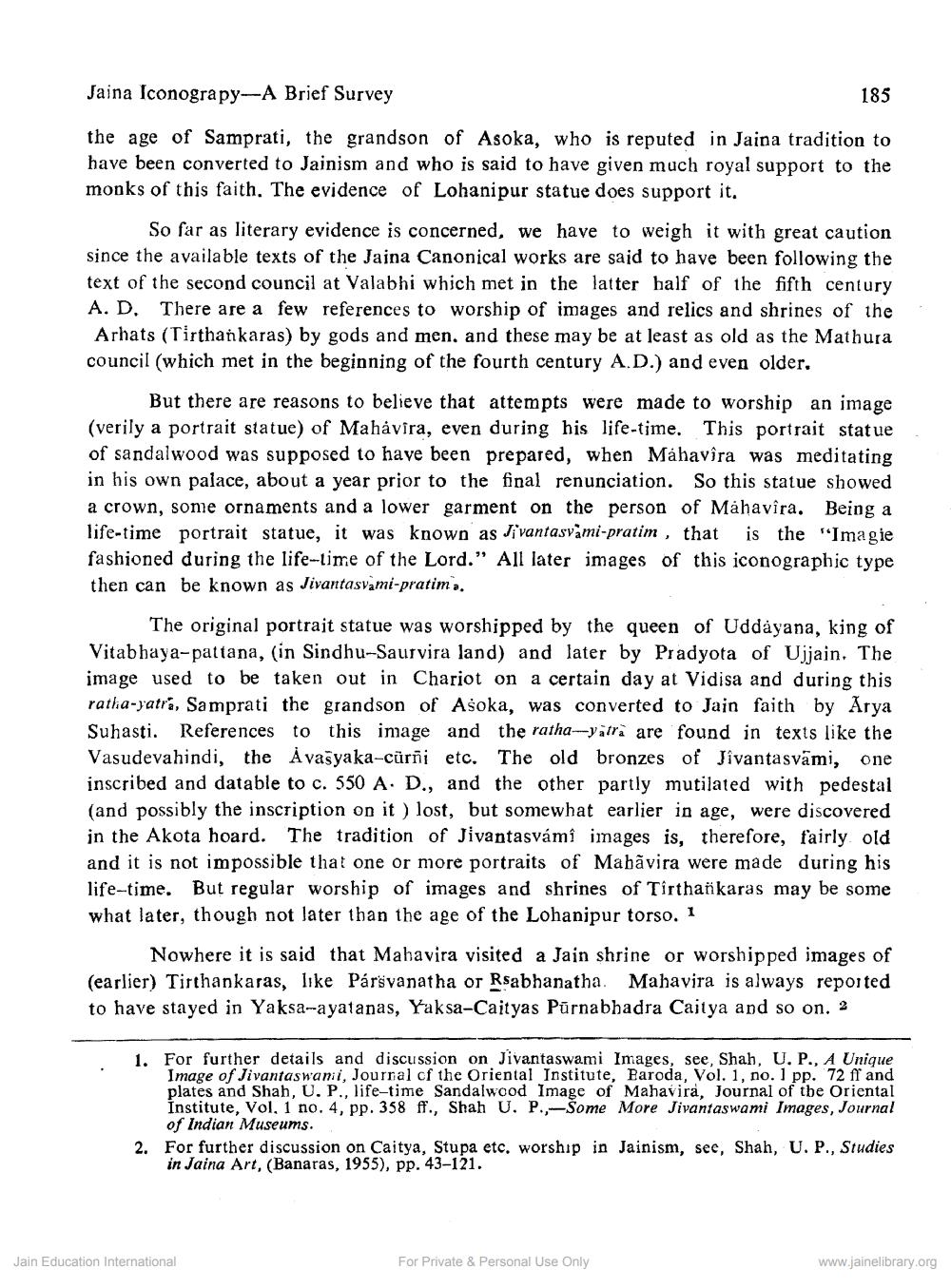________________
Jaina Iconograpy-A Brief Survey
185
the age of Samprati, the grandson of Asoka, who is reputed in Jaina tradition to have been converted to Jainism and who is said to have given much royal support to the monks of this faith. The evidence of Lohanipur statue does support it,
So far as literary evidence is concerned, we have to weigh it with great caution since the available texts of the Jaina Canonical works are said to have been following the text of the second council at Valabhi which met in the latter half of the fifth century A. D. There are a few references to worship of images and relics and shrines of the Arhats (Tirthankaras) by gods and men, and these may be at least as old as the Mathura council (which met in the beginning of the fourth century A.D.) and even older.
But there are reasons to believe that attempts were made to worship an image (verily a portrait statue) of Mahåvira, even during his life-time. This portrait statue of sandalwood was supposed to have been prepared, when Mahavira was meditating in his own palace, about a year prior to the final renunciation. So this statue showed a crown, some ornaments and a lower garment on the person of Mahavira. Being a life-time portrait statue, it was known as Jivantasvämi-pratim, that is the "Imagie fashioned during the life-lime of the Lord." All later images of this iconographic type then can be known as Jivantasvami-pratima.
The original portrait statue was worshipped by the queen of Uddayana, king of Vitabhaya-pattana, (in Sindhu-Saurvira land) and later by Pradyota of Ujjain. The image used to be taken out in Chariot on a certain day at Vidisa and during this ratha-yatra, Samprati the grandson of Asoka, was converted to Jain faith by Arya Suhasti. References to this image and the ratha--yatra are found in texts like the Vasudevahindi, the À vasyaka-curñi etc. The old bronzes of Jivantasvāmi, one inscribed and datable to c. 550 A. D., and the other partly mutilated with pedestal (and possibly the inscription on it ) lost, but somewhat earlier in age, were discovered in the Akota hoard. The tradition of Jivantasvámî images is, therefore, fairly old and it is not impossible that one or more portraits of Mahävira were made during his life-time. But regular worship of images and shrines of Tirthařkaras may be some what later, though not later than the age of the Lohanipur torso. 1
Nowhere it is said that Mahavira visited a Jain shrine or worshipped images of (earlier) Tirthankaras, like Pársvanatha or Rsabhanatha. Mahavira is always reported to have stayed in Yaksa-ayatanas, Yaksa-Caityas Pūrnabhadra Caitya and so on. 2
1. For further details and discussion on Jivantaswami Images, see. Shah. U. P.. A Unique
Image of Jivantaswamii, Journal of the Oriental Institute, Paroda, Vol. 1, no.1 pp. 72 ff and plates and Shah, U.P., life-time Sandalwood Image of Mahavira, Journal of the Oriental Institute, Vol. 1 no. 4, pp. 358 ff., Shah U. P.,Some More Jivantaswami Images, Journal of Indian Museums. For further discussion on Caitya, Stupa etc. worship in Jainism, see, Shah, U. P., Studies in Jaina Art, (Banaras, 1955), pp. 43-121.
Jain Education International
For Private & Personal Use Only
www.jainelibrary.org




